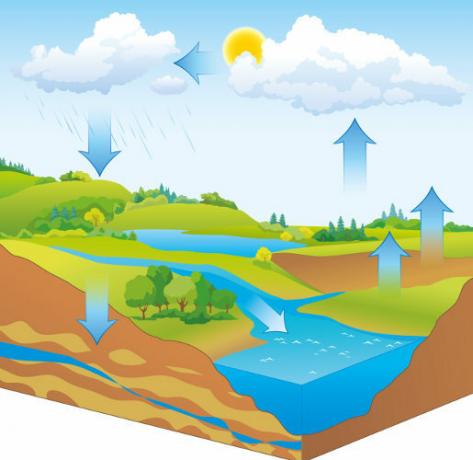monoculture represents the cultivation of a single plant species, like soybeans. There is also animal monoculture, which corresponds to the creation of a single animal species, like cattle. Usually, this agricultural activity is carried out on latifundios (extensive rural properties).
The practice of monoculture is associated with several environmental impacts, such as the impoverishment of the ground, the removal of vegetation cover and the ecological imbalance.
How is monoculture practiced?
The practice of monoculture is related to production for export. Therefore, the choice of the product to be cultivated or created is associated with the international market. For monoculture to be carried out, a large tract of land is needed, which must be properly prepared. For this, it is necessary that the entire vegetation cover of the area intended for cultivation/creation is removed, an action that causes several damage to the environment.
Briefly, the practice involves the following processes:
Removal of vegetation cover
Soil preparation for planting
Growing a single product in the same area over and over again
Intense use of pesticides
Consequences of monoculture
The realization of monoculture triggers several damages to the environment. Cultivating a single species can cause soil exhaust, causing the depletion of its nutrients and, consequently, nutritional impoverishment.
also know: Other forms of soil degradation
Another problem associated with the recurrent cultivation of a species in the same area is the intense use of pesticides and fertilizers, used to control pests and weeds. Misuse of these agricultural advocates can lead to ground contamination and consequently, from groundwater and other water resources. Water pollution also causes the contamination of aquatic life, causing a huge ecological imbalance.
For the monoculture to be carried out, the area must be prepared. For this, it is necessary to deforest large tracts of land. O logging it causes changes in the climate, loss of biodiversity and extinction of several species, which lose their habitat and their source of food.
Read more:Deforestation in Brazil
Advantages and disadvantages
Benefits |
Disadvantages |
Production in less time |
Nutritional impoverishment and soil exhaustion |
Reduced production costs |
Favorable conditions for the large-scale existence of pests and diseases |
Easier use of herbicides |
Removal of vegetation cover |
Maintenance of the pest and disease cycle |
Ecological imbalance and loss of biodiversity |
Highly expressive species production for the export economy |
Exploitation of water resources for irrigation |
Monoculture in Brazil
Monoculture has been practiced in Brazil since the colonial period. European countries practiced the so-called plantations of export, a colonial agricultural system based on large estates, monoculture, slave labor and production for export.
The cultivation of a single product has been characteristic of Brazil's agrarian structure since the beginning of its agrarian development, in the 16th century. This practice began in the country with the monoculture of sugar cane in the Zona da Mata region (Northeast region), where it was more pronounced, in São Paulo and Minas Gerais. This production was exported to European countries.
From the introduction of new agricultural techniques and seeds through the green revolution, monoculture was boosted. Agriculture started to produce a single product on a large scale for the export market.
At the end of the 19th century and beginning of the 20th century, the coffee won the agricultural scenario, becoming the main agricultural export product of the Brazilian economy. Coffee monoculture was carried out in the states of Rio de Janeiro and São Paulo and was also associated with large estates and slave labor in the fields.
Do not stop now... There's more after the advertising ;)
Read more:coffee economy
Nowadays, soy is the protagonist of agricultural production aimed at export. The advance of this production began in the 1970s. In 2017, Brazil became the largest exporter of soybeans and is currently the second largest producer in the world.
Sugar cane monoculture
Sugarcane monoculture in Brazil began in the 16th century, especially in the Northeast of the country, due to favorable climatic conditions and the characteristics of the soil and relief. Aimed at the export market, sugarcane production was, for a long period, the basis of the country's economy.
Read too:Sugarcane production in São Paulo
Currently, Brazil produces more than half of the sugar used worldwide, being also considered the largest producer of ethanol. In 2009, sugarcane production reached 670 million tons. In 2017, production exceeded 694 million tons.
In addition to being used for the production of ethanol, sugarcane also generates by-products, such as bagasse used in energy production (biomass), food, pharmaceutical, and chemical industry products.
In Brazil, there are around 400 sugarcane processing plants, which are mainly concentrated in the Southeast region of the country. Despite this, this cultivation has expanded to the Midwest region. In the country, the area destined to the monoculture of sugarcane represents approximately 3% of the total arable land.

Sugarcane is one of the biggest representatives of monoculture in Brazil.
Examples of monocultures
In addition to sugarcane, soy, coffee and eucalyptus crops represent the main examples of monocultures in Brazil.
→ Cultivation of Soy

Brazil is the largest soy exporter in the world.
Read too:Soy expansion in Brazil
→ coffee growing

Coffee production in Brazil dates back to the 19th century and is concentrated in the Southeast region of the country.
Also know:Coffee roots in Brazil
→ Eucalyptus cultivation

Eucalyptus monoculture in Brazil is concentrated in the Southeast, Northeast and Midwest regions.
Know more: Reforestation with eucalyptus in Brazil
Polyculture

Polyculture is the cultivation or creation of various agricultural or animal species in the same area, whose production supplies the domestic market.
monoculture |
Polyculture |
|
- Cultivation or breeding of a single agricultural or animal species - Carried out on large estates - Production geared towards export - Associated with slave labor - Causes several damages to the environment - Greater technological employment |
- Cultivation of various plant or animal species in the same area - Carried out by small rural producers on small tracts of land - Production aimed at internal supply and subsistence - Associated with family work - Sustainable form of agricultural production - Less technological employment |
by Rafaela Sousa
Graduated in Geography


